Aquatic plant

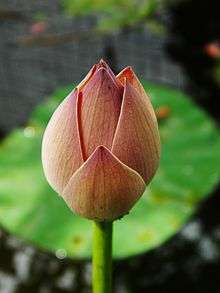
Aquatic plants are plants that have adapted to living in aquatic environments (saltwater or freshwater). They are also referred to as hydrophytes or macrophytes. A macrophyte is an aquatic plant that grows in or near water and is either emergent, submergent, or floating, and includes helophytes (a plant that grows in marsh, partly submerged in water, so that it regrows from buds below the water surface).[1] In lakes and rivers macrophytes provide cover for fish and substrate for aquatic invertebrates, produce oxygen, and act as food for some fish and wildlife.[2]
Aquatic plants require special adaptations for living submerged in water, or at the water's surface. The most common adaptation is aerenchyma, but floating leaves and finely dissected leaves are also common.[3][4][5] Aquatic plants can only grow in water or in soil that is permanently saturated with water. They are therefore a common component of wetlands.[6]
Fringing stands of tall vegetation by water basins and rivers may include helophytes. Examples include stands of Equisetum fluviatile, Glyceria maxima, Hippuris vulgaris, Sagittaria, Carex, Schoenoplectus, Sparganium, Acorus, yellow flag (Iris pseudacorus), Typha and Phragmites australis.
Distribution
The principal factor controlling the distribution of aquatic plants is the depth and duration of flooding. However, other factors may also control their distribution, abundance, and growth form, including nutrients, disturbance from waves, grazing, and salinity.[6]
Evolution
Aquatic vascular plants have originated on multiple occasions in different plant families;[3][7] they can be ferns or angiosperms (including both monocots and dicots). Seaweeds are not vascular plants; rather they are multicellular marine algae, and therefore are not typically included among aquatic plants. A few aquatic plants are able to survive in brackish, saline, and salt water.[3] The only angiosperms capable of growing completely submerged in seawater are the seagrasses.[8] Examples are found in genera such as Thalassia and Zostera. Although most aquatic plants can reproduce by flowering and setting seed, many also have extensive asexual reproduction by means of rhizomes, turions, and fragments in general.[4]
One of the largest aquatic plants in the world is the Amazon water lily; one of the smallest is the minute duckweed. Many small aquatic animals use plants like duckweed for a home, or for protection from predators, but areas with more vegetation are likely to have more predators. Some other familiar examples of aquatic plants might include floating heart, water lily, lotus, and water hyacinth.
Classification of macrophytes
Based on growth form, macrophytes can be classified as:
- Emergent macrophytes
- Floating-leaved macrophytes
- Submerged macrophytes
- Free floating macrophytes
Emergent
An emergent plant is one which grows in water but which pierces the surface so that it is partially in air. Collectively, such plants are emergent vegetation.
This habit may have developed because the leaves can photosynthesize more efficiently above the shade of cloudy water and competition from submerged plants but often, the main aerial feature is the flower and the related reproductive process. The emergent habit permits pollination by wind or by flying insects.
There are many species of emergent plants, among them, the reed (Phragmites), Cyperus papyrus, Typha species, flowering rush and wild rice species. These may be found growing in fens but usually less well owing to competition from other plants. Some species, such as purple loosestrife, may grow in water as emergent plants but they are capable of flourishing in fens or simply in damp ground.[9]
Floating-leaved
Floating-leaved macrophytes have root system attached to the substrates or bottom of the lake and stream and with leaves that float on the water surface. Common floating leaves macrophytes are water lilies (family Nymphaeaceae), pondweeds (family Potamogetonaceae).
Submerged
Submerged macrophytes completely grow under water with root attached to the substrate (e.g. Myriophyllum spicatum) or without any root system (e.g. Ceratophyllum demersum).
Free-floating
Free-floating macrophytes are aquatic plants that are found suspended on water surface with their root not attached to substrate or sediment or bottom of water body. They are easily blown by air and provide breeding ground for mosquito. Example include Pistia spp commonly called water lettuce, water cabbage or Nile cabbage
Morphological classification
The many possible classifications of aquatic plants are based upon morphology.[3] One example has six groups as follows:[10]
- Amphiphytes: plants that are adapted to live either submerged or on land
- Elodeids: stem plants that complete their entire lifecycle submerged, or with only their flowers above the waterline
- Isoetids: rosette plants that complete their entire lifecycle submerged
- Helophytes: plants rooted in the bottom, but with leaves above the waterline
- Nymphaeids: plants rooted in the bottom, but with leaves floating on the water surface
- Pleuston: vascular plants that float freely in the water
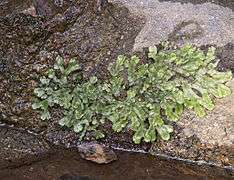
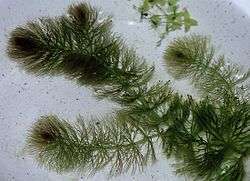
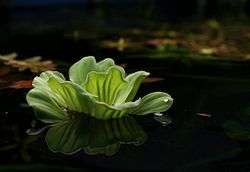
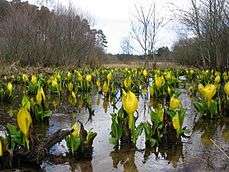
Functions of macrophytes in aquatic system
Macrophytes perform many ecosystem functions in aquatic ecosystems and provide services to human society. One of the important functions performed by macrophyte is uptake of dissolve nutrients (N and P) from water.[11] Macrophytes are widely used in constructed wetlands around the world to remove excess N and P from polluted water.[12] Beside direct nutrient uptake, macrophytes indirectly influence nutrient cycling, especially N cycling through influencing the denitrifying bacterial functional groups that are inhabiting on roots and shoots of macrophytes.[13] Macrophytes promote the sedimentation of suspended solids by reducing the current velocities,[14] impede erosion by stabilising soil surfaces.[15] Macrophytes also provide spatial heterogeneity in otherwise unstructured water column. Habitat complexity provided by macrophytes like to increase the richness of taxonomy and density of both fish and invertebrates.[16]
Uses and importance
Food crops
Some aquatic plants are used by humans as a food source. Examples include wild rice (Zizania), water caltrop (Trapa natans), Chinese water chestnut (Eleocharis dulcis), Indian lotus (Nelumbo nucifera), water spinach (Ipomoea aquatica), and watercress (Rorippa nasturtium-aquaticum).
Watershed health indicators
A decline in a macrophyte community may indicate water quality problems and changes in the ecological status of the water body. Such problems may be the result of excessive turbidity, herbicides, or salinization. Conversely, overly high nutrient levels may create an overabundance of macrophytes, which may in turn interfere with lake processing.[2]
Macrophyte levels are easy to sample, do not require laboratory analysis, and are easily used for calculating simple abundance metrics.[2]
Potential sources of therapeutic agents
Phytochemical and pharmacological researches suggest that freshwater macrophytes, such as Centella asiatica, Nelumbo nucifera, Nasturtium officinale, Ipomoea aquatica and Ludwigia adscendens, are promising sources of anticancer and antioxidative natural products.[17]
Hot water extracts of the stem and root of Ludwigia adscendens, as well as those of the fruit, leaf and stem of Monochoria hastata were found to have lipoxygenase inhibitory activity. Hot water extract prepared from the leaf of Ludwigia adscendens exhibits alpha-glucosidase inhibitory activity more potent than that of acarbose.[18]
See also
References
- ↑ Hickey, M.; King, C. (2001). The Cambridge Illustrated Glossary of Botanical Terms. Cambridge University Press.
- 1 2 3 "Macrophytes as Indicators of freshwater marshes in Florida" (PDF). Retrieved 2014-04-05.
- 1 2 3 4 Sculthorpe, C. D. 1967. The Biology of Aquatic Vascular Plants. Reprinted 1985 Edward Arnold, by London.
- 1 2 Hutchinson, G. E. 1975. A Treatise on Limnology, Vol. 3, Limnological Botany. New York: John Wiley.
- ↑ Cook, C.D.K. (ed). 1974. Water Plants of the World. Dr W Junk Publishers, The Hague. ISBN 90-6193-024-3.
- 1 2 Keddy, P.A. 2010. Wetland Ecology: Principles and Conservation (2nd edition). Cambridge University Press, Cambridge, UK. 497 p.
- ↑ Tomlinson, P. B. 1986. The Botany of Mangroves. Cambridge, UK: Cambridge University Press.
- ↑ "Alismatales". Angiosperm Phylogeny Website. Missouri Botanical Garden.
- ↑ Swearingen, Jil M. (7 July 2009). "PCA Alien Plant Working Group - Purple Loosestrife (Lythrum salicaria)". National Park Service. Retrieved 24 September 2011.
- ↑ Westlake, D.F., Kvĕt, J. and Szczepański, A. 1998. The Production Ecology of Wetlands. Cambridge University Press, Cambridge. 568 p.
- ↑ Brix, H. (1997) Do macrophytes play a role in constructed treatment wetlands?. Water Science and Technology, 35, 11-17
- ↑ Vymazal, J. (2013) Emergent plants used in free water surface constructed wetlands: A review. Ecological Engineering, 61, 582-592.
- ↑ Hallin, S., Hellman, M., Choudhury, M.I. & Ecke, F. (2015) Relative importance of plant uptake and plant associated denitrification for removal of nitrogen from mine drainage in sub-arctic wetlands. Water Research, 85, 377-383.
- ↑ Zhu, M.Y., Zhu, G.W., Nurminen, L., Wu, T.F., Deng, J.M., Zhang, Y.L., Qin, B.Q. & Ventela, A.M. (2015) The Influence of Macrophytes on Sediment Resuspension and the Effect of Associated Nutrients in a Shallow and Large Lake (Lake Taihu, China). PLoS ONE, 10.
- ↑ Horppila, J., Kaitaranta, J., Joensuu, L. & Nurminen, L. (2013) Influence of emergent macrophyte (Phragmites australis) density on water turbulence and erosion of organic-rich sediment. Journal of Hydrodynamics, 25, 288-293.
- ↑ THOMAZ, S. M., DIBBLE, E. D., EVANGELISTA, L. R., HIGUTI, J. and BINI, L. M. (2008) Influence of aquatic macrophyte habitat complexity on invertebrate abundance and richness in tropical lagoons. Freshwater Biology, 53: 358–367. doi:10.1111/j.1365-2427.2007.01898.x
- ↑ Chai TT, Ooh KF, Quah Y, Wong FC (2015) Edible freshwater macrophytes: a source of anticancer and antioxidative natural products—a mini-review. Phytochemistry Reviews 14(3): 443–457
- ↑ Ooh KF, Ong HC, Wong FC, Sit NW, Chai TT (2014) High performance liquid chromatography profiling of health-promoting phytochemicals and evaluation of antioxidant, anti-lipoxygenase, iron chelating and anti-glucosidase activities of wetland macrophytes. Pharmacognosy Magazine 10(39): 443-455.
External links
| Wikimedia Commons has media related to Aquatic plants. |

